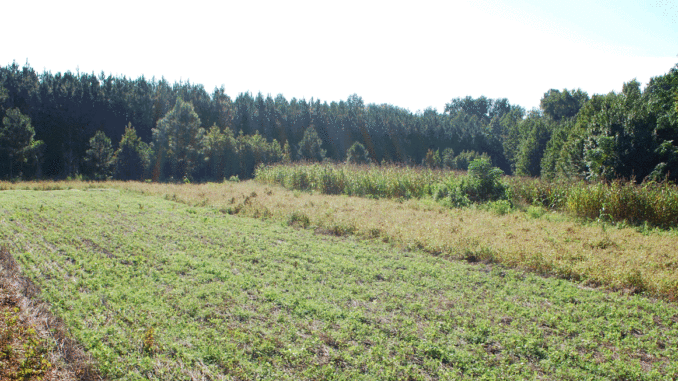
Whitetails’ food needs span several months
August is a vital month for food-plot junkies hoping for an attractive nourishment center for deer season. But cruising through fields and woods or cultivating potential plots during the sweltering August heat is not a preferred activity in the South. Ninety-degree days and 100-percent humidity keeps most folks near or inundated in air conditioning. Luckily, the cool-season planting period is still a month away, but hunters can prepare their food-plot plan for the upcoming season this month. Planting season is just around the corner!
Hopefully, by August, hunters have decided which fields and rights-of-way will be destined for a cool- season food plot. Most cool-season varieties should be drilled, planted or broadcast by Oct. 1, leaving a little better than a month to dispense herbicide, purchase seed and fertilizer and begin turning dirt. Ground preparations will be consistent through the entire acreage destined for a food plot; specific plantings and arrangement can sometimes be difficult to determine, but they will decide which places will be producing food throughout the season.
Even though deer hunting will overlap with the September planting season, tree stands overlooking warm-season food plots, local agriculture fields and water holes will be the place to be. Forage availability will vary from emergence to four weeks away for selected cool-season crops. As the season progresses, natural food sources and agriculture foods will become less available, making food plots more attractive.
Basically, there are two main schools of thought for cool-season food plot arrangements. Plan A will include different seeds in each plot that will emerge and mature at different times to make sure browse is available through the end of the season. Wildlife managers can stagger plant groups of rows of different crops that mature at different times to offer food throughout the season. For instance, a 25-foot corridor of brassicas can be alternated with another 25-foot corridor of oats, peas or an annual clover. The brassicas become attractive to deer after the first heavy frost and usually provide a month of growth before heavy browsing begins. The oats, peas and/or annual clover will become attractive immediately after emergence. The 25-foot corridors can be alternated across a field or plot.
Plan A is recommend for farms with fewer food plots and an overall limited availability of food for wildlife. Hunters should be careful not to put too much pressure on these plots during hunting season. They are intended to last the entire season, and hunting pressure will shift deer usage to after dark.
Plan B also incorporates a multi-crop planting regime, but with a different spin, aimed at properties that have numerous food plots scattered throughout the acreage.
Basically, Plan B prescribes full plantings of crops with similar maturation dates in each plot, but alternating plantings per plot and at different planting intervals. For instance, if 10 food plots are evenly scattered across the property, plots 1, 3, 5, 7 and 9 will be planted with crops that can be browsed immediately after emergence. The even-numbered plots could be planted with brassicas, providing a delayed use later in the season.
Theoretically, deer will start eating at the odd-numbered plots first early in the season, and then move to the even-numbered plots as the green patches mature. Deer will generally migrate to rich food sources as they become available.
Plan B helps concentrate deer in certain areas and keeps them from scattering across property lines. In areas with high deer densities, plots will be over-browsed shortly after they become attractive to wildlife. The staggered maturation of crops should allow certain plots to recover while others become available.
If hunters want to go to another level, food-plot planting times can be staggered between plots to offer food availability during different periods and to concentrate deer in certain areas at different times.




Be the first to comment